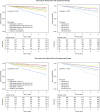Physical Function and Mortality in Older Adults with Chronic Kidney Disease
- PMID: 39115956
- PMCID: PMC11469788
- DOI: 10.2215/CJN.0000000000000515
Physical Function and Mortality in Older Adults with Chronic Kidney Disease
Abstract
Key Points:
Using data from the Chronic Renal Insufficiency Cohort study, we found that death in older adults with CKD is associated with (1) slow walking speed and (2) frailty.
The elevated risk of death with slow walking speed or frailty persisted even if kidney failure with replacement therapy was pursued.
When older adults with CKD and their families face treatment decisions, clinicians should utilize walking speed to frame discussions of prognosis.
Background: Accurate mortality prediction can guide clinical care for older adults with CKD. Yet existing tools do not incorporate physical function, an independent predictor of death in older adults. We determined whether incorporating physical function measurements improve mortality prediction among older adults with CKD.
Methods: We included Chronic Renal Insufficiency Cohort participants who were 65 years and older, had eGFR <60 ml/min per 1.73 m2, not receiving kidney failure with replacement therapy (KFRT), and had least one gait speed assessment. Gait speed was measured at usual pace (≥0.84, 0.83–0.65, 0.64–0.47, ≤0.46 m/s, or unable), and frailty was assessed using Physical Frailty Phenotype criteria (range 0–5 points, also known as Fried criteria). We modeled time to all-cause death over 5 years using Cox proportional hazard models, treating KFRT as censored and noncensored events in separate analyses. C-statistics assessed model discrimination.
Results: Among 2338 persons, mean age was 70±4 years, 43% were female, and 43% were Black. Mean eGFR was 42±13 ml/min per 1.73 m2, and median urine albumin-to-creatinine ratio was 33 mg/g (Q1 9, Q3 206). Over a median follow-period of 5 years, 392 died and 164 developed KFRT. In censored analyses, adding gait speed or frailty improved mortality risk prediction. The C-statistic changed from 0.69 to 0.72 with gait speed scores and from 0.70 to 0.73 with frailty scores. The performance of models with gait speed or frailty was similar in noncensored analyses.
Conclusions: Among older adults with CKD, adding measures of physical function modestly improves mortality prediction.
Conflict of interest statement
Disclosure forms, as provided by each author, are available with the online version of the article at
Figures




References
-
- United States Renal Data System. 2021 USRDS Annual Data Report, 2021. Accessed September 12, 2022. https://adr.usrds.org/2021
Grants and funding
- UL1TR000003/TR/NCATS NIH HHS/United States
- UL1TR000439/TR/NCATS NIH HHS/United States
- U01 DK060963/DK/NIDDK NIH HHS/United States
- K24 AG073615/AG/NIA NIH HHS/United States
- U01DK060990/DK/NIDDK NIH HHS/United States
- U01 DK061022/DK/NIDDK NIH HHS/United States
- R01 DK119199/DK/NIDDK NIH HHS/United States
- UL1 TR000003/TR/NCATS NIH HHS/United States
- UL1 RR-024131/Kaiser Permanente NIH/NCRR UCSF-CTSI
- UL1 TR000439/TR/NCATS NIH HHS/United States
- R01DK119199/DK/NIDDK NIH HHS/United States
- U01DK061022/DK/NIDDK NIH HHS/United States
- U01 DK060990/DK/NIDDK NIH HHS/United States
- U01DK060963/DK/NIDDK NIH HHS/United States
- U24DK060990/DK/NIDDK NIH HHS/United States
- K24AG073615/AG/NIA NIH HHS/United States
- UL1RR029879/TR/NCATS NIH HHS/United States
- UL1 RR029879/RR/NCRR NIH HHS/United States
- U01DK061028/DK/NIDDK NIH HHS/United States
- U01 DK061028/DK/NIDDK NIH HHS/United States
- UL1 TR000433/TR/NCATS NIH HHS/United States
- U01DK061021/DK/NIDDK NIH HHS/United States
- R01DK133509/DK/NIDDK NIH HHS/United States
- U01 DK060984/DK/NIDDK NIH HHS/United States
- U01 DK061021/DK/NIDDK NIH HHS/United States
- M01 RR-16500/University of Maryland
- U24 DK060990/DK/NIDDK NIH HHS/United States
- UL1TR000433/Michigan Institute for Clinical and Health Research
- U01 DK060980/DK/NIDDK NIH HHS/United States
- K23 AG057813/AG/NIA NIH HHS/United States
- R01 DK133509/DK/NIDDK NIH HHS/United States
- U01DK060980/DK/NIDDK NIH HHS/United States
- U01DK060902/DK/NIDDK NIH HHS/United States
- U01DK060984/DK/NIDDK NIH HHS/United States
- UL1 RR024131/RR/NCRR NIH HHS/United States
- K23AG057813/AG/NIA NIH HHS/United States
- M01 RR016500/RR/NCRR NIH HHS/United States
- P20 GM109036/GM/NIGMS NIH HHS/United States
- U01 DK060902/DK/NIDDK NIH HHS/United States
- K24AG073615/AG/NIA NIH HHS/United States
- K23AG057813/AG/NIA NIH HHS/United States
- R01DK133509/DK/NIDDK NIH HHS/United States
- U01DK060990/DK/NIDDK NIH HHS/United States
- U01DK060984/DK/NIDDK NIH HHS/United States
- U01DK061022/DK/NIDDK NIH HHS/United States
- U01DK061021/DK/NIDDK NIH HHS/United States
- U01DK061028/DK/NIDDK NIH HHS/United States
- U01DK060980/DK/NIDDK NIH HHS/United States
- U01DK060963/DK/NIDDK NIH HHS/United States
- U01DK060902/DK/NIDDK NIH HHS/United States
- U24DK060990/DK/NIDDK NIH HHS/United States
- UL1TR000003/TR/NCATS NIH HHS/United States
- UL1TR000439/TR/NCATS NIH HHS/United States
- UL1RR029879/TR/NCATS NIH HHS/United States
- P20 GM109036/GM/NIGMS NIH HHS/United States
- R01DK119199/DK/NIDDK NIH HHS/United States
LinkOut - more resources
Full Text Sources
Research Materials
Miscellaneous

